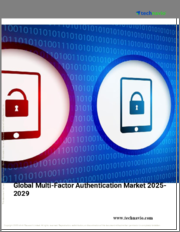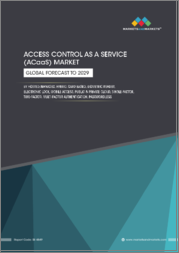
|
시장보고서
상품코드
1829614
다중 인증 시장 : 모델별, 조직 규모별, 전개 방식별, 업종별 - 세계 예측(2025-2032년)Multi-factor Authentication Market by Model, Organization Size, Deployment Mode, Vertical - Global Forecast 2025-2032 |
||||||
다중 인증 시장은 2032년까지 CAGR 12.45%로 557억 7,000만 달러로 성장할 것으로 예측됩니다.
| 주요 시장 통계 | |
|---|---|
| 예측 연도(2024년) | 218억 달러 |
| 기준 연도(2025년) | 245억 5,000만 달러 |
| 예측 연도(2032년) | 557억 7,000만 달러 |
| CAGR(%) | 12.45% |
다중 인증이 리스크 감소와 원활한 사용자 경험을 동시에 제공하는 전략적 비즈니스 인에이블러로 진화하고 있음을 설명하는 미래지향적 맥락의 도입부
다중 인증은 위협의 벡터가 증가하고 ID 공격이 점점 더 교묘해짐에 따라 기술적 관리에서 전략적 인에이블러로 변화하고 있습니다. 현재 환경에서 보안 리더는 자동화된 크리덴셜 기반 침입에 대한 장벽을 높이는 동시에 정당한 사용자의 마찰을 줄여야 한다는 두 가지 요구사항 사이에서 균형을 맞춰야 합니다. 그 결과, 다중 인증은 이제 기술적 견고성뿐만 아니라 운영 적합성, 사용자 경험, 그리고 광범위한 ID 생태계와의 통합에 대한 평가가 이루어지고 있습니다.
사이버 적들이 진화함에 따라 방어 아키텍처도 진화하고 있습니다. 조직은 기존의 토큰 및 비밀번호 기반 요소에 더해 행동, 생체인식 및 컨텍스트 신호를 통합하고 있습니다. 이러한 진화에 따라 보안, IT 운영 및 비즈니스 부서 간 기능 간 협업이 필요하며, 고객 여정 및 직원 생산성 목표에 따라 도입이 이루어져야 합니다. 궁극적으로 다중 인증에 대한 성숙한 접근 방식은 하이브리드 인프라와 클라우드 네이티브 애플리케이션에 걸쳐 탄력성과 확장성을 유지하면서 디지털 전환 이니셔티브를 지원하는 비즈니스 인에이블러로 설계되어 있습니다.
위협의 고도화, 규제의 진화, 사용자 기대에 따른 변혁적 변화에 대한 분석이 인증 전략과 도입을 재구성하고 있습니다.
인증의 규제 상황은 위협의 고도화, 규제의 발전, 사용자의 기대라는 세 가지 요인에 의해 크게 변화하고 있습니다. 위협자들은 크리덴셜 스터핑, 피싱, 피싱 및 공급망 기법을 점점 더 많이 악용하고 있으며, 방어자들은 적응형 위험 기반 제어를 통합한 계층화된 인증 전략을 채택해야 합니다. 규제 프레임워크와 업계 표준은 동시에 아이덴티티와 액세스 관리의 기준을 높이고, 조직에 효과적인 관리와 사고 대비 태세를 입증해야 하는 새로운 의무를 부과하고 있습니다.
한편, 사용자들은 기기와 채널을 넘나들며 마찰 없는 액세스를 기대하게 되었고, 강력한 인증과 낮은 대기 시간 경험을 결합해야 한다는 압박이 커지고 있습니다. 이러한 역동적인 움직임은 컨텍스트와 기기의 태도가 허용하는 한 암호 없는 패러다임과 생체 인증의 채택을 가속화하고 있습니다. 또한, 클라우드 도입과 API 중심 아키텍처로 인해 아이덴티티 경계가 더욱 분산되어 중앙 집중식 정책의 오케스트레이션과 페더레이션이 중요해지고 있습니다. 그 결과, 시장은 포인트 솔루션에서 하이브리드 에스테이트 전체에 일관된 정책 시행과 텔레메트리를 제공할 수 있는 통합 ID 플랫폼으로 이동하고 있습니다.
2025년 미국 관세 조정으로 인해 인증 솔루션 공급망 역학, 조달 전략, 도입 계획이 어떻게 변화했는지를 증거에 기반하여 평가합니다.
2025년에 발표된 정책 전환과 관세 조정은 인증 시스템에 사용되는 부품 및 장치에 영향을 미치는 세계 공급망 전체에 새로운 고려 사항을 도입했습니다. 하드웨어 토큰 제조업체와 생체인식 주변기기 제조업체는 특정 무역 경로의 투입 비용 상승에 직면하여 일부 공급업체는 지역 제조 및 다양한 조달로 전환하는 전략을 취했습니다. 그 결과, 기업들은 벤더의 탄력성과 온프레미스 및 하이브리드 구축의 총소유비용을 재평가하고, 조달 주기가 길어졌습니다.
관세는 하드웨어뿐만 아니라 현지화된 클라우드 인프라 및 엣지 디바이스 프로비저닝에 대한 전략적 결정에도 영향을 미쳤습니다. 규제가 엄격한 분야에서 사업을 영위하는 기업들은 국경 간 무역의 혼란에 노출될 위험을 줄이기 위해 공급망 실적과 공급업체의 계약 조건 평가에 박차를 가하고 있습니다. 과도기적 결과로, 많은 조달팀은 지리적으로 분산된 공급망과 투명한 부품 조달을 제공하는 공급업체를 우선적으로 선택했습니다. 이러한 변화는 도입 일정과 통합 로드맵에 영향을 미치며, 보안 설계자가 인증 기술 선택과 라이프사이클 계획에 공급망 위험 평가를 포함시켜야 할 필요성을 강조하고 있습니다.
인증 모델, 조직 규모, 배포 방식 선택, 산업별 요구사항이 솔루션 선택을 결정하는 방법을 설명하는 세분화 기반 수요 역학에 대한 심층적인 연구
세분화 분석을 통해 인증 모델, 조직 규모, 구축 방식 선택, 업종별 제약 조건에 따라 서로 다른 수요 패턴과 기술 요구 사항을 파악할 수 있습니다. 모델에 따라 시장은 5단계 인증, 4단계 인증, 3단계 인증, 2단계 인증으로 분류됩니다. 고요소 구현은 고가치 트랜잭션이나 특권적 접근 시나리오에서 고려되고 있으며, 이러한 시나리오에서 적의 성공 가능성은 낮아집니다. 대기업은 보통 기존 아이덴티티 패브릭과의 통합과 중앙 집중식 정책 오케스트레이션을 우선시하지만, 중소기업은 관리 오버헤드를 최소화하고 빠른 Time-to-Value를 실현할 수 있는 턴키 솔루션을 찾는 경우가 많습니다.
목차
제1장 서론
제2장 분석 방법
제3장 주요 요약
제4장 시장 개요
제5장 시장 인사이트
제6장 미국 관세의 누적 영향 2025
제7장 AI의 누적 영향 2025
제8장 다중 인증 시장 : 모델별
- 5 요소 인증
- 4 요소 인증
- 삼요소인증
- 2 요소 인증
제9장 다중 인증 시장 : 조직 규모별
- 대기업
- 중소기업
제10장 다중 인증 시장 : 전개 방식별
- 클라우드
- 온프레미스
제11장 다중 인증 시장 : 업종별
- BFSI
- 정부
- 의료
- IT·통신
- 소매업
제12장 다중 인증 시장 : 지역별
- 아메리카
- 북미
- 라틴아메리카
- 유럽, 중동 및 아프리카
- 유럽
- 중동
- 아프리카
- 아시아태평양
제13장 다중 인증 시장 : 그룹별
- ASEAN
- GCC
- EU
- BRICS
- G7
- NATO
제14장 다중 인증 시장 : 국가별
- 미국
- 캐나다
- 멕시코
- 브라질
- 영국
- 독일
- 프랑스
- 러시아
- 이탈리아
- 스페인
- 중국
- 인도
- 일본
- 호주
- 한국
제15장 경쟁 구도
- 시장 점유율 분석(2024년)
- FPNV 포지셔닝 매트릭스(2024년)
- 경쟁 분석
- Microsoft Corporation
- Cisco Systems, Inc.
- International Business Machines Corporation
- Okta, Inc.
- Ping Identity Corporation
- RSA Security LLC
- Thales Group
- HID Global Corporation
- Google LLC
- OneSpan Inc.
The Multi-factor Authentication Market is projected to grow by USD 55.77 billion at a CAGR of 12.45% by 2032.
| KEY MARKET STATISTICS | |
|---|---|
| Base Year [2024] | USD 21.80 billion |
| Estimated Year [2025] | USD 24.55 billion |
| Forecast Year [2032] | USD 55.77 billion |
| CAGR (%) | 12.45% |
A forward-looking contextual introduction explaining how multi-factor authentication has evolved into a strategic business enabler balancing risk reduction and seamless user experiences
Multi-factor authentication has shifted from a technical control to a strategic enabler for organizations navigating heightened threat vectors and increasingly sophisticated identity attacks. In the current environment, security leaders must weigh the twin imperatives of reducing friction for legitimate users while raising the barrier against automated and credential-based intrusions. Consequently, multi-factor authentication is now assessed not only on technical robustness but also on its operational fit, user experience, and integration with broader identity ecosystems.
As cyber adversaries evolve, so too do defensive architectures; organizations are integrating behavioral, biometric, and contextual signals alongside traditional token and password-based factors. This evolution demands cross-functional collaboration between security, IT operations, and business units to ensure deployments align with customer journeys and workforce productivity goals. Ultimately, mature approaches to multi-factor authentication are those that are architected as business enablers-supporting digital transformation initiatives-while remaining resilient and scalable across hybrid infrastructure and cloud-native applications.
An analysis of transformative shifts driven by threat sophistication, regulatory evolution, and user expectations reshaping authentication strategies and deployments
The landscape for authentication has experienced transformative shifts driven by three converging forces: threat sophistication, regulatory attention, and user expectation. Threat actors increasingly exploit credential stuffing, phishing, and supply chain techniques, prompting defenders to adopt layered authentication strategies that incorporate adaptive, risk-based controls. Regulatory frameworks and industry standards have concurrently raised the bar for Identity and Access Management, placing new obligations on organizations to demonstrate effective controls and incident readiness.
Meanwhile, users now expect frictionless access across devices and channels, creating pressure to blend strong authentication with low-latency experiences. This dynamic has accelerated adoption of passwordless paradigms and biometric verification where context and device posture permit. Additionally, cloud adoption and API-driven architectures have led to more distributed identity perimeters, making centralized policy orchestration and federation critical. As a result, the market has shifted from point solutions toward integrated identity platforms capable of delivering consistent policy enforcement and telemetry across hybrid estates.
An evidence-based assessment of how United States tariff adjustments in 2025 altered supply chain dynamics, procurement strategies, and deployment planning for authentication solutions
Policy shifts and tariff adjustments announced in 2025 introduced new considerations across global supply chains that affect components and devices used in authentication systems. Hardware token producers and manufacturers of biometric peripherals faced increased input costs in certain trade lanes, prompting some vendor strategies to pivot toward regionalized manufacturing and diversified sourcing. In turn, procurement cycles lengthened as enterprises reassessed vendor resilience and total cost of ownership for on-premise and hybrid deployments.
Beyond hardware, tariffs influenced strategic decisions around localized cloud infrastructure and edge device provisioning. Organizations operating in highly regulated sectors accelerated evaluations of supply chain provenance and vendor contractual terms to mitigate exposure to cross-border trade disruptions. As a transitional consequence, many procurement teams prioritized vendors with geographically distributed supply chains and transparent component sourcing. This shift has implications for deployment timelines and integration roadmaps, and it underscores the need for security architects to incorporate supply chain risk assessments into authentication technology selection and lifecycle planning.
A granular exploration of segmentation-driven demand dynamics explaining how authentication models, organizational scale, deployment choices, and vertical requirements shape solution selection
Segmentation analysis reveals differentiated demand patterns and technical requirements driven by authentication models, organizational scale, deployment choices, and vertical-specific constraints. Based on Model, market is studied across Five factor authentication, Four factor authentication, Three factor authentication, and Two factor authentication; higher-factor implementations are increasingly considered for high-value transactions and privileged access scenarios where layered assurances reduce adversary success likelihood. Based on Organization Size, market is studied across Large Enterprises and SMEs; large enterprises typically prioritize integration with existing identity fabrics and centralized policy orchestration, while SMEs often seek turnkey solutions that minimize administrative overhead and deliver rapid time-to-value.
Based on Deployment Mode, market is studied across Cloud and On Premise; cloud-first organizations benefit from continuous updates and scalable policy engines, whereas regulated entities may maintain on-premise or hybrid configurations to meet data residency and audit obligations. Based on Vertical, market is studied across BFSI, Government, Healthcare, IT And Telecom, and Retail; each vertical imposes distinct requirements-BFSI demands strong transaction authentication and auditability, government emphasizes compliance and supply chain transparency, healthcare focuses on patient and caregiver privacy, IT and telecom prioritize scale and federation, and retail balances secure payments with customer experience optimization. These intersecting segmentation axes inform how vendors design use-case specific feature sets and how buyers prioritize risk versus convenience.
A nuanced regional analysis revealing how differing regulatory regimes, ecosystem maturity, and user behavior across the Americas, Europe Middle East & Africa, and Asia-Pacific influence authentication strategies
Regional dynamics are shaping deployment preferences and investment priorities as organizations align identity strategies with local regulatory regimes and ecosystem maturity. In the Americas, momentum favors cloud-native identity platforms and passwordless adoption in both enterprise and consumer-facing contexts, supported by dense vendor ecosystems and a focus on integration with modern workforce tooling. Transitional factors include data residency debates and the need for consistent cross-border trust frameworks that preserve user experience while meeting compliance obligations.
In Europe, Middle East & Africa, regulatory diversity and privacy-centric approaches are driving a mix of on-premise and cloud-hybrid configurations, with public sector and regulated industries often requiring demonstrable supply chain controls. Localized certification schemes and national identity initiatives create opportunities for interoperable biometric and federation-based models. In Asia-Pacific, rapid digital service adoption and high mobile-first usage patterns are pushing innovation in biometric modalities and mobile-centric authentication flows, while regional variations in vendor maturity and procurement practices lead to a wide dispersion in deployment architectures. Collectively, these regional patterns influence vendor go-to-market strategies and integration priorities.
Insights into competitive vendor strategies showing how platform extensibility, partnerships, and experience-led design are redefining provider differentiation in authentication markets
Competitive dynamics among companies in the authentication ecosystem are converging around platform extensibility, partnerships, and experience-centric design. Established identity providers and emerging specialists are investing in API-first architectures and developer tooling to lower integration friction and to foster ecosystems of complementary services. Meanwhile, hardware manufacturers and biometric technology firms are focusing on interoperability standards and certification pathways to ensure their devices can be embedded within broader identity frameworks.
Strategic partnerships between cloud service providers, system integrators, and identity technology vendors are enabling bundled offerings that address end-to-end use cases from workforce access to customer authentication. Product roadmaps emphasize telemetry, adaptive risk scoring, and orchestration capabilities that allow organizations to apply consistent policies across fragmented estates. Additionally, service models are expanding to include managed authentication stacks and outcome-based engagements that align vendor incentives with operational uptime and fraud reduction objectives. These commercial and technical trends are shaping how buyers evaluate vendors on criteria that extend beyond feature lists to include operational support, compliance posture, and partnership ecosystems.
Actionable strategic and operational recommendations that help industry leaders pragmatically implement resilient, low-friction authentication while managing supply chain and vendor risk
Leaders should adopt a pragmatic, phased approach that aligns security objectives with business outcomes and user experience goals. Begin by mapping high-risk access pathways and prioritizing use cases where incremental authentication factors materially reduce exposure, and then pilot adaptive, context-aware policies that escalate assurance only when risk signals exceed predefined thresholds. This minimizes friction for routine operations while providing stronger guarantees for sensitive actions.
Concurrently, leaders must enforce rigorous vendor due diligence and supply chain assessment, ensuring contractual clarity on provenance, firmware update practices, and incident responsibilities. Where feasible, favor vendors that provide robust APIs and integration templates to accelerate deployment and to enable centralized logging and analytics. Invest in workforce enablement to reduce configuration errors and to cultivate an operational model that treats identity as a shared business capability rather than a siloed IT function. Finally, establish measurable operational metrics-such as time-to-recovery for credential compromise and false rejection rates for critical user cohorts-to govern continuous improvement and to align investments with demonstrable risk reduction.
A transparent and rigorous mixed-methods research methodology combining expert interviews, secondary analysis, case synthesis, and triangulation to ensure reliability and practical relevance
The research methodology integrates qualitative and structured approaches to produce a balanced, evidence-based assessment of the authentication landscape. Primary data was collected through expert interviews with security leaders, identity architects, and procurement professionals to surface decision drivers, deployment challenges, and operational practices. Secondary sources, such as vendor documentation, standards bodies, regulatory guidance, and academic literature, were reviewed to contextualize technical approaches and to verify claims related to protocols and interoperability.
Analysts applied triangulation techniques to reconcile divergent perspectives and to ensure findings are robust across different enterprise contexts. Case study analysis highlighted implementation patterns and lessons learned, while thematic synthesis distilled recurring success factors and risk vectors. Throughout, emphasis was placed on transparency in assumptions, explicit articulation of scope and limitations, and ethical handling of sensitive information. Validation steps included peer review by independent practitioners and iterative refinement based on stakeholder feedback to ensure practical relevance and methodological rigor.
A conclusive synthesis emphasizing the need for adaptive, user-centric authentication programs that integrate supply chain awareness and measurable operational governance
In conclusion, multi-factor authentication has matured into a strategic control that must be implemented with an eye toward usability, supply chain resilience, and policy orchestration across hybrid environments. The interplay of technological innovation, regulatory pressure, and evolving threat techniques requires organizations to move beyond checkbox compliance toward identity programs that are adaptive, auditable, and aligned with business processes. Practitioners who balance risk-based controls with user-centric design will be better positioned to harden access pathways while preserving productivity.
Looking ahead, durable programs will emphasize interoperability, telemetry-driven policy adjustments, and clear accountability across procurement and operations. By prioritizing use cases that yield the greatest risk reduction per unit of user friction and by embedding supply chain considerations into vendor selection, organizations can achieve stronger security postures without undermining the digital experiences that drive adoption and growth. Continued cross-functional collaboration and disciplined measurement will determine which implementations deliver sustainable value over time.
Table of Contents
1. Preface
- 1.1. Objectives of the Study
- 1.2. Market Segmentation & Coverage
- 1.3. Years Considered for the Study
- 1.4. Currency & Pricing
- 1.5. Language
- 1.6. Stakeholders
2. Research Methodology
3. Executive Summary
4. Market Overview
5. Market Insights
- 5.1. Adoption of passwordless authentication solutions leveraging FIDO2 standards for improved security
- 5.2. Integration of behavioral biometrics with MFA to detect anomalies and reduce false positives
- 5.3. Expansion of MFA deployment in critical infrastructure sectors including healthcare and energy
- 5.4. Increasing use of adaptive risk-based authentication to dynamically adjust MFA requirements by context
- 5.5. Growing integration of decentralized identity frameworks with MFA for improved user privacy control
- 5.6. Rising demand for cloud-native MFA services with seamless API integrations and scalability features
- 5.7. Use of mobile device toeprinting and cryptographic attestation in MFA for enhanced fraud prevention
- 5.8. Emergence of interoperable MFA ecosystems enabling single tap authentication across multiple platforms
6. Cumulative Impact of United States Tariffs 2025
7. Cumulative Impact of Artificial Intelligence 2025
8. Multi-factor Authentication Market, by Model
- 8.1. Five factor authentication
- 8.2. Four factor authentication
- 8.3. Three factor authentication
- 8.4. Two factor authentication
9. Multi-factor Authentication Market, by Organization Size
- 9.1. Large Enterprises
- 9.2. SMEs
10. Multi-factor Authentication Market, by Deployment Mode
- 10.1. Cloud
- 10.2. On Premise
11. Multi-factor Authentication Market, by Vertical
- 11.1. BFSI
- 11.2. Government
- 11.3. Healthcare
- 11.4. IT And Telecom
- 11.5. Retail
12. Multi-factor Authentication Market, by Region
- 12.1. Americas
- 12.1.1. North America
- 12.1.2. Latin America
- 12.2. Europe, Middle East & Africa
- 12.2.1. Europe
- 12.2.2. Middle East
- 12.2.3. Africa
- 12.3. Asia-Pacific
13. Multi-factor Authentication Market, by Group
- 13.1. ASEAN
- 13.2. GCC
- 13.3. European Union
- 13.4. BRICS
- 13.5. G7
- 13.6. NATO
14. Multi-factor Authentication Market, by Country
- 14.1. United States
- 14.2. Canada
- 14.3. Mexico
- 14.4. Brazil
- 14.5. United Kingdom
- 14.6. Germany
- 14.7. France
- 14.8. Russia
- 14.9. Italy
- 14.10. Spain
- 14.11. China
- 14.12. India
- 14.13. Japan
- 14.14. Australia
- 14.15. South Korea
15. Competitive Landscape
- 15.1. Market Share Analysis, 2024
- 15.2. FPNV Positioning Matrix, 2024
- 15.3. Competitive Analysis
- 15.3.1. Microsoft Corporation
- 15.3.2. Cisco Systems, Inc.
- 15.3.3. International Business Machines Corporation
- 15.3.4. Okta, Inc.
- 15.3.5. Ping Identity Corporation
- 15.3.6. RSA Security LLC
- 15.3.7. Thales Group
- 15.3.8. HID Global Corporation
- 15.3.9. Google LLC
- 15.3.10. OneSpan Inc.



















